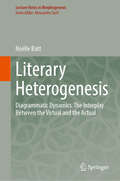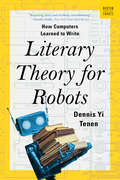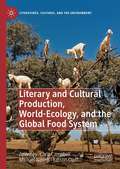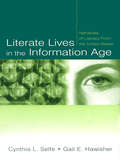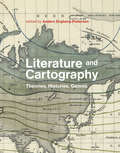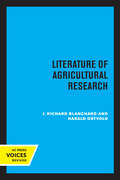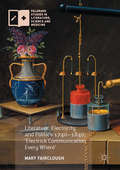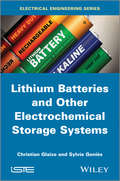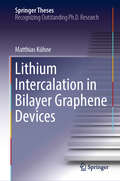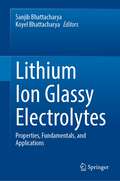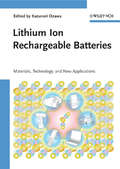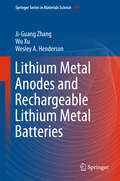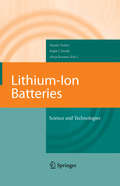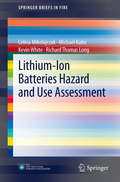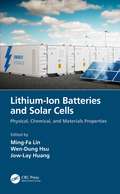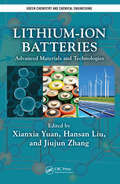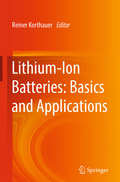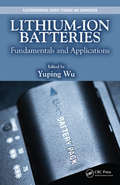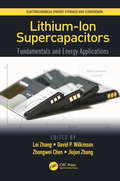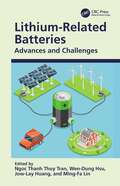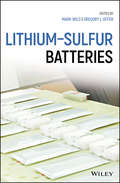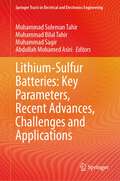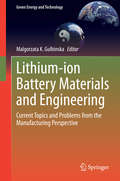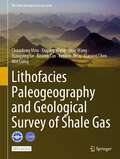- Table View
- List View
Literary Heterogenesis: Diagrammatic Dynamics. The Interplay Between the Virtual and the Actual (Lecture Notes in Morphogenesis)
by Noëlle BattThis book advances a new interdisciplinary approach that engages with the concepts of science and literature through the mediation of philosophy (with a focus on the ideas of Gilbert Simondon and Gilles Deleuze). It investigates in innovative ways the multifaceted dimensions of creation, of genesis, considered here in artistic and mathematical terms as “heterogenesis”. The dialogic interaction among the three domains generates a renewed analysis of poems selected in the work of particularly inventive poets, both French and American—Emily Dickinson, e.e. cummings and Francis Ponge—as well as the artwork of Pierre Soulages, Anna-Eva Bergman and Cy Twombly. Literary Heterogenesis. Diagrammatic Dynamics. The Interplay of the Virtual and the Actual will interest specialists of mathematics, physics, literary theory and criticism, philosophy, and epistemology. It will also attract any curious mind drawn to the bridging of disciplines and the concepts of the two cultures.
Literary Theory for Robots: How Computers Learned to Write (A Norton Short #0)
by Dennis Yi Tenen“Surprising, funny and resolutely unintimidating.” —Jennifer Szalai, New York Times Book Review In the industrial age, automation came for the shoemaker and the seamstress. Today, it has come for the writer, physician, programmer, and attorney. Literary Theory for Robots reveals the hidden history of modern machine intelligence, taking readers on a spellbinding journey from medieval Arabic philosophy to visions of a universal language, past Hollywood fiction factories and missile defense systems trained on Russian folktales. In this provocative reflection on the shared pasts of literature and computer science, former Microsoft engineer and professor of comparative literature Dennis Yi Tenen provides crucial context for recent developments in AI, which holds important lessons for the future of humans living with smart technology. Intelligence expressed through technology should not be mistaken for a magical genie, capable of self-directed thought or action. Rather, in highly original and effervescent prose with a generous dose of wit, Yi Tenen asks us to read past the artifice—to better perceive the mechanics of collaborative work. Something as simple as a spell-checker or a grammar-correction tool, embedded in every word-processor, represents the culmination of a shared human effort, spanning centuries. Smart tools, like dictionaries and grammar books, have always accompanied the act of writing, thinking, and communicating. That these paper machines are now automated does not bring them to life. Nor can we cede agency over the creative process. With its masterful blend of history, technology, and philosophy, Yi Tenen’s work ultimately urges us to view AI as a matter of labor history, celebrating the long-standing cooperation between authors and engineers.
Literary and Cultural Production, World-Ecology, and the Global Food System (Literatures, Cultures, and the Environment)
by Chris Campbell Michael Niblett Kerstin OloffLiterary and Cultural Production, World-Ecology, and the Global Food System marks a significant intervention into the field of literary food studies. Drawing on new work in world literature, cultural studies, and environmental studies, the essays gathered here explore how literary and cultural texts have represented and responded to the global food system from the late nineteenth century to the present day. Covering topics such as the impact of colonial monocultures and industrial agriculture, enclosure and the loss of the commons, the meatification of diets, the toxification of landscapes, and the consequences of climate breakdown, the volume ranges across the globe, from Thailand to Brazil, Cyprus to the Caribbean. Whether it is anxieties over imported meat in late Victorian Britain, labour struggles on Guatemalan banana plantations, or food dependency in Puerto Rico, the contributors to this volume show how fiction, poetry, drama, film, and music have critically explored and contributed to food cultures worldwide.
Literate Lives in the Information Age: Narratives of Literacy From the United States
by Cynthia L. Selfe Gail E. HawisherThis book chronicles the development of electronic literacies through the stories of individuals with varying backgrounds and skills. Authors Cynthia L. Selfe and Gail E. Hawisher employ these stories to begin tracing technological literacy as it has emerged over the last few decades within the United States. They selected 20 case studies from the corpus of more than 350 people who participated in interviews or completed a technological literacy questionnaire during six years of their study. The book is organized into seven chapters that follow the 20 participants in their efforts to acquire varying degrees of technological literacy. Each chapter situates the participants' life-history accounts in the cultural ecology of the time, tracing major political, economic, social, and educational events, factors, and trends that may have influenced--and been influenced by--literacy practices and values. These literacy histories are richly sown with information that can help those in composition and writing studies situate the processes of acquiring the literacies of technology in specific cultural, material, educational, and familial contexts. These case studies provide initial clues about combinations of factors that affect--and are affected by--technological literacy acquisition and development. The first-hand accounts presented here offer, in abundant detail, everyday literacy experiences that can help educators, parents, policymakers, and writing teachers respond to today's students in more informed ways.
Literature After Darwin
by Virginia RichterWhat makes us human? Where is the limit between human and animal? These are questions that haunt post-Darwinian literature. Covering fiction from Kipling to Kafka, this study offers a historically embedded analysis of anthropological anxiety in the period between the publication of the Origin of Species and the beginning of the Second World War.
Literature and Cartography: Theories, Histories, Genres (The\mit Press Ser.)
by Anders Engberg-PedersenThe relationship of texts and maps, and the mappability of literature, examined from Homer to Houellebecq.Literary authors have frequently called on elements of cartography to ground fictional space, to visualize sites, and to help readers get their bearings in the imaginative world of the text. Today, the convergence of digital mapping and globalization has spurred a cartographic turn in literature. This book gathers leading scholars to consider the relationship of literature and cartography. Generously illustrated with full-color maps and visualizations, it offers the first systematic overview of an emerging approach to the study of literature.The literary map is not merely an illustrative guide but represents a set of relations and tensions that raise questions about representation, fiction, and space. Is literature even mappable? In exploring the cartographic components of literature, the contributors have not only brought literary theory to bear on the map but have also enriched the vocabulary and perspectives of literary studies with cartographic terms. After establishing the theoretical and methodological terrain, they trace important developments in the history of literary cartography, considering topics that include Homer and Joyce, Goethe and the representation of nature, and African cartographies. Finally, they consider cartographic genres that reveal the broader connections between texts and maps, discussing literary map genres in American literature and the coexistence of image and text in early maps. When cartographic aspirations outstripped factual knowledge, mapmakers turned to textual fictions.ContributorsJean-Marc Besse, Bruno Bosteels, Patrick M. Bray, Martin Brückner, Tom Conley, Jörg Dünne, Anders Engberg-Pedersen, John K. Noyes, Ricardo Padrón, Barbara Piatti, Simone Pinet, Clara Rowland, Oliver Simons, Robert Stockhammer, Dominic Thomas, Burkhardt Wolf
Literature of Agricultural Research
by J. Richard Blanchard Harald OstvoldThis title is part of UC Press's Voices Revived program, which commemorates University of California Press’s mission to seek out and cultivate the brightest minds and give them voice, reach, and impact. Drawing on a backlist dating to 1893, Voices Revived makes high-quality, peer-reviewed scholarship accessible once again using print-on-demand technology. This title was originally published in 1958.
Literature, Electricity and Politics 1740–1840
by Mary FaircloughThis book investigates the science of electricity in the long eighteenth century and its textual life in literary and political writings. Electricity was celebrated as a symbol of enlightened progress, but its operation and its utility were unsettlingly obscure. As a result, debates about the nature of electricity dovetailed with discussions of the relation between body and soul, the nature of sexual attraction, the properties of revolutionary communication and the mysteries of vitality. This study explores the complex textual manifestations of electricity between 1740 and 1840, in which commentators describe it both as a material force and as a purely figurative one. The book analyses attempts by both elite and popular practitioners of electricity to elucidate the mysteries of electricity, and traces the figurative uses of electrical language in the works of writers including Mary Robinson, Edmund Burke, Erasmus Darwin, John Thelwall, Mary Shelley and Richard Carlile.
Lithium Batteries and other Electrochemical Storage Systems (Wiley-iste Ser.)
by Christian Glaize Sylvie GeniesLithium batteries were introduced relatively recently in comparison to lead- or nickel-based batteries, which have been around for over 100 years. Nevertheless, in the space of 20 years, they have acquired a considerable market share – particularly for the supply of mobile devices. We are still a long way from exhausting the possibilities that they offer. Numerous projects will undoubtedly further improve their performances in the years to come. For large-scale storage systems, other types of batteries are also worthy of consideration: hot batteries and redox flow systems, for example. This book begins by showing the diversity of applications for secondary batteries and the main characteristics required of them in terms of storage. After a chapter presenting the definitions and measuring methods used in the world of electrochemical storage, and another that gives examples of the applications of batteries, the remainder of this book is given over to describing the batteries developed recently (end of the 20th Century) which are now being commercialized, as well as those with a bright future. The authors also touch upon the increasingly rapid evolution of the technologies, particularly regarding lithium batteries, for which the avenues of research are extremely varied. Contents Part 1. Storage Requirements Characteristics of Secondary Batteries Examples of Use 1. Breakdown of Storage Requirements. 2. Definitions and Measuring Methods. 3. Practical Examples Using Electrochemical Storage. Part 2. Lithium Batteries 4. Introduction to Lithium Batteries. 5. The Basic Elements in Lithium-ion Batteries: Electrodes, Electrolytes and Collectors. 6. Usual Lithium-ion Batteries. 7. Present and Future Developments Regarding Lithium-ion Batteries. 8. Lithium-Metal Polymer Batteries. 9. Lithium-Sulfur Batteries. 10. Lithium-Air Batteries. 11. Lithium Resources. Part 3. Other Types of Batteries 12. Other Types of Batteries. About the Authors Christian Glaize is Professor at the University of Montpellier, France. He is also Researcher in the Materials and Energy Group (GEM) of the Institute for Electronics (IES), France. Sylvie Geniès is a project manager at the French Alternative Energies and Atomic Energy Commission (Commissariat à l’Energie Atomique et aux Energies Alternatives) in Grenoble, France.
Lithium Intercalation in Bilayer Graphene Devices (Springer Theses)
by Matthias KühneThis book reports on the successful implementation of an innovative, miniaturized galvanic cell that offers unprecedented control over and access to ionic transport. It represents a milestone in fundamental studies on the diffusive transport of lithium ions between two atomically thin layers of carbon (graphene), a highly relevant aspect in electrodes for energy and mass storage in the context of batteries. Further, it is a beautiful example of how interdisciplinary work that combines expertise from two very distinct fields can significantly advance science. Machinery and tools common in the study of low-dimensional systems in condensed matter physics are combined with methods routinely employed in electrochemistry to enable truly unique and powerful experiments. The method developed here can easily be generalized and extended to other layered materials as well as other ionic species. Not only the method but also the outcome of its application to Li diffusion and intercalation in bilayer graphene is remarkable. A record chemical diffusion coefficient is demonstrated, exceeding even the diffusion of sodium chloride in water and surpassing any reported value of ion diffusion in single-phase mixed conducting materials. This finding may be indicative of the exceptional properties yet to be discovered in nanoscale derivatives of bulk insertion compounds.
Lithium Ion Glassy Electrolytes: Properties, Fundamentals, and Applications
by Sanjib Bhattacharya Koyel BhattacharyaThis book presents recent developments and future scopes of glassy systems, such as their electrical and optical properties, use as electrodes, photonics devices, battery applications and others, which are of great interest for material scientists and professionals. Each chapter is designed to increase coherence, containing examples and question sets as exercises for in-depth understanding of the text. It provides a valuable resource for researchers, professionals and students in the area of material research especially on Li-doped glasses.
Lithium Ion Rechargeable Batteries: Materials, Technology, and New Applications
by Kazunori OzawaStarting out with an introduction to the fundamentals of lithium ion batteries, this book begins by describing in detail the new materials for all four major uses as cathodes, anodes, separators, and electrolytes. It then goes on to address such critical issues as self-discharge and passivation effects, highlighting lithium ion diffusion and its profound effect on a battery's power density, life cycle and safety issues. The monograph concludes with a detailed chapter on lithium ion battery use in hybrid electric vehicles. Invaluable reading for materials scientists, electrochemists, physicists, and those working in the automobile and electrotechnical industries, as well as those working in computer hardware and the semiconductor industry.
Lithium Metal Anodes and Rechargeable Lithium Metal Batteries
by Ji-Guang Zhang Wu Xu Wesley A. HendersonThis book provides comprehensive coverage of Lithium (Li) metal anodes for rechargeable batteries. Li is an ideal anode material for rechargeable batteries due to its extremely high theoretical specific capacity (3860 mAh g-1), low density (0. 59 g cm-3), and the lowest negative electrochemical potential (−3. 040 V vs. standard hydrogenelectrodes). Unfortunately, uncontrollable dendritic Li growth and limited Coulombic efficiency during Li deposition/stripping inherent in these batteries have prevented their practical applications over the past 40 years. With the emergence of post Liion batteries, safe and efficient operation of Li metal anodes has become an enabling technology which may determine the fate of several promising candidates for the next generation energy storage systems, including rechargeable Li-air batteries, Li-S batteries, and Li metal batteries which utilize intercalation compounds as cathodes. In this work, various factors that affect the morphology and Coulombic efficiency of Li anodes are analyzed. The authors also present the technologies utilized to characterize the morphology of Li deposition and the results obtained by modeling of Li dendrite growth. Finally, recent developments, especially the new approaches that enable safe and efficient operation of Li metal anodes at high current densities are reviewed. The urgent need and perspectives in this field are also discussed. The fundamental understanding and approaches presented in this work will be critical for the application of Li metal anodes. The general principles and approaches can also be used in other metal electrodes and general electrochemical deposition of metal films.
Lithium-Ion Batteries
by Ralph J. Brodd Akiya Kozawa Masaki YoshioThis book is a compilation of up-to-date information relative to Li-Ion technology. It provides the reader with a single source covering all important aspects of Li-Ion battery operations. It fills the gap between the old original Li-Ion technology and present state of the technology that has developed into a high state of practice. The book is designed to provide a single source for an up-to-date description of the technology associated with the Li-Ion battery industry. It will be useful to researchers interested in energy conversion for the direct conversion of chemical energy into electrical energy as a textbook. University people will find a comprehensive description of the state-of-the-art of the Li-Ion system.
Lithium-Ion Batteries Hazard and Use Assessment
by Michael Kahn Richard Thomas Long Celina Mikolajczak Kevin WhiteLithium-Ion Batteries Hazard and Use Assessment examines the usage of lithium-ion batteries and cells within consumer, industrial and transportation products, and analyzes the potential hazards associated with their prolonged use. This book also surveys the applicable codes and standards for lithium-ion technology. Lithium-Ion Batteries Hazard and Use Assessment is designed for practitioners as a reference guide for lithium-ion batteries and cells. Researchers working in a related field will also find the book valuable.
Lithium-Ion Batteries and Solar Cells: Physical, Chemical, and Materials Properties
by Ming-Fa Lin Wen-Dung Hsu Jow-Lay HuangLithium-Ion Batteries and Solar Cells: Physical, Chemical, and Materials Properties presents a thorough investigation of diverse physical, chemical, and materials properties and special functionalities of lithium-ion batteries and solar cells. It covers theoretical simulations and high-resolution experimental measurements that promote a full understanding of the basic science to develop excellent device performance. Employs first-principles and the machine learning method to fully explore the rich and unique phenomena of cathode, anode, and electrolyte (solid and liquid states) in lithium-ion batteries Develops distinct experimental methods and techniques to enhance the performance of lithium-ion batteries and solar cells Reviews syntheses, fabrication, and measurements Discusses open issues, challenges, and potential commercial applications This book is aimed at materials scientists, chemical engineers, and electrical engineers developing enhanced batteries and solar cells for peak performance.
Lithium-Ion Batteries: Advanced Materials and Technologies (Green Chemistry and Chemical Engineering)
by Jiujun Zhang Hansan Liu Xianxia YuanWritten by a group of top scientists and engineers in academic and industrial R&D, Lithium-Ion Batteries: Advanced Materials and Technologies gives a clear picture of the current status of these highly efficient batteries. Leading international specialists from universities, government laboratories, and the lithium-ion battery industry share th
Lithium-Ion Batteries: Basics and Applications
by Reiner KorthauerThe handbook focuses on a complete outline of lithium-ion batteries. Just before starting with an exposition of the fundamentals of this system, the book gives a short explanation of the newest cell generation. The most important elements are described as negative / positive electrode materials, electrolytes, seals and separators. The battery disconnect unit and the battery management system are important parts of modern lithium-ion batteries. An economical, faultless and efficient battery production is a must today and is represented with one chapter in the handbook. Cross-cutting issues like electrical, chemical, functional safety are further topics. Last but not least standards and transportation themes are the final chapters of the handbook. The different topics of the handbook provide a good knowledge base not only for those working daily on electrochemical energy storage, but also to scientists, engineers and students concerned in modern battery systems.
Lithium-Ion Batteries: Fundamentals and Applications (Electrochemical Energy Storage And Conversion Ser. #4)
by Yuping WuLithium-Ion Batteries: Fundamentals and Applications offers a comprehensive treatment of the principles, background, design, production, and use of lithium-ion batteries. Based on a solid foundation of long-term research work, this authoritative monograph:Introduces the underlying theory and history of lithium-ion batteriesDescribes the key compone
Lithium-Ion Supercapacitors: Fundamentals and Energy Applications (Electrochemical Energy Storage and Conversion)
by Lei Zhang Jiujun Zhang Zhongwei Chen David P. WilkinsonThe book provides a comprehensive understanding of the principles for operating lithium-ion supercapacitors (LISCs), their challenges, technological trends and perspectives. LISC technology has high potential to replace conventional rechargeable batteries such as lead-acid and nickel metal hydride batteries for automotive, portable electronics, and stationary applications. The book offers detailed analysis of LISCs at the material, component, and system levels to evaluate the different approaches to their integration. It also discusses economics, market, manufacture, and commercialization status of LISCs. It is an up-to-date study of an emerging field, written by experts, ideal for those in academia and industry who want a detailed explanation of the technology.
Lithium-Related Batteries: Advances and Challenges
by Ngoc Thanh Thuy TranThis book serves as a comprehensive treatment of the advanced microscopic properties of lithium- and sodium-based batteries. It focuses on the development of the quasiparticle framework and the successful syntheses of cathode/electrolyte/anode materials in these batteries. FEATURES Highlights lithium-ion and sodium-ion batteries as well as lithium sulfur-, aluminum-, and iron-related batteries Describes advanced battery materials and their fundamental properties Addresses challenges to improving battery performance Develops theoretical predictions and experimental observations under a unified quasiparticle framework Targets core issues such as stability and efficiencies Lithium-Related Batteries: Advances and Challenges will appeal to researchers and advanced students working in battery development, including those in the fields of materials, chemical, and energy engineering.
Lithium-Sulfur Batteries
by Mark Wild Gregory J. OfferA guide to lithium sulfur batteries that explores their materials, electrochemical mechanisms and modelling and includes recent scientific developments Lithium Sulfur Batteries (Li-S) offers a comprehensive examination of Li-S batteries from the viewpoint of the materials used in their construction, the underlying electrochemical mechanisms and how this translates into the characteristics of Li-S batteries. The authors – noted experts in the field – outline the approaches and techniques required to model Li-S batteries. Lithium Sulfur Batteries reviews the application of Li-S batteries for commercial use and explores many broader issues including the development of battery management systems to control the unique characteristics of Li-S batteries. The authors include information onsulfur cathodes, electrolytes and other components used in making Li-S batteries and examine the role of lithium sulfide, the shuttle mechanism and its effects, and degradation mechanisms. The book contains a review of battery design and: Discusses electrochemistry of Li-S batteries and the analytical techniques used to study Li-S batteries Offers information on the application of Li-S batteries for commercial use Distills years of research on Li-S batteries into one comprehensive volume Includes contributions from many leading scientists in the field of Li-S batteries Explores the potential of Li-S batteries to power larger battery applications such as automobiles, aviation and space vehicles Written for academic researchers, industrial scientists and engineers with an interest in the research, development, manufacture and application of next generation battery technologies, Lithium Sulfur Batteries is an essential resource for accessing information on the construction and application of Li-S batteries.
Lithium-Sulfur Batteries: Key Parameters, Recent Advances, Challenges and Applications (Springer Tracts in Electrical and Electronics Engineering)
by Abdullah Mohamed Asiri Muhammad Sagir Muhammad Bilal Tahir Muhammad Suleman TahirThis book provides an excellent review and analysis of the latest information on rechargeable Li-S battery research. With a clear and concise writing style and in-depth technical material, this book will appeal to undergraduates and graduates, researchers, chemists, material scientists, and physicists working in the field of energy storage, especially those with an interest in Li-S battery technology. IEEE Electrical Insulation Magazine shows lithium-sulfur (Li-S) batteries give us an alternative to the more prevalent lithium-ion (Li-ion) versions and are known for their observed high-energy densities. Systems using Li-S batteries are in the early stages of development, and commercialization however could potentially provide higher, safer levels of energy at significantly lower cost. In this book, the history, scientific background, challenges, and future perspectives of the lithium-sulfur system are presented by experts in the field. Focus is on past and recent advances of each cell compartment responsible for the performance of the Li-S battery and includes analysis of characterization tools, new designs, and computational modeling. As a comprehensive review of the current state of play, it is ideal for undergraduates, graduate students, researchers, physicists, chemists, and materials scientists interested in energy storage, material science, and electrochemistry.
Lithium-ion Battery Materials and Engineering
by Malgorzata K. GulbinskaGaining public attention due, in part, to their potential application as energy storage devices in cars, Lithium-ion batteries have encountered widespread demand, however, the understanding of lithium-ion technology has often lagged behind production. This book defines the most commonly encountered challenges from the perspective of a high-end lithium-ion manufacturer with two decades of experience with lithium-ion batteries and over six decades of experience with batteries of other chemistries. Authors with years of experience in the applied science and engineering of lithium-ion batteries gather to share their view on where lithium-ion technology stands now, what are the main challenges, and their possible solutions. The book contains real-life examples of how a subtle change in cell components can have a considerable effect on cell's performance. Examples are supported with approachable basic science commentaries. Providing a unique combination of practical know-how with an in-depth perspective, this book will appeal to graduate students, young faculty members, or others interested in the current research and development trends in lithium-ion technology.
Lithofacies Paleogeography and Geological Survey of Shale Gas (The China Geological Survey Series)
by Wei Liang Chuanlong Mou Xiuping Wang Qiyu Wang Xiangying Ge Bowen Zan Kenken Zhou Xiaowei ChenThis is an open access book. This book presents new theory and methods on compiling lithofacies paleogeographic maps as a key tool for guiding geological survey on shale gas. The fundamental goal of the shale gas geological survey is to find the ‘dessert’ area. It is therefore suggested that the lithofacies paleogeographic study and the technique of mapping should be a solid scientific basis for shale gas exploration. It takes Ordovician Wufeng-Silurian Longmaxi Formation in Sichuan Basin and its adjacent area as an example to illustrate how to find the ‘dessert’ area of shale gas in geological survey phase by compiling lithofacies paleogeographic map. It’s a valuable reference for both scientific research and teaching courses in the fields of sedimentary lithofacies, paleogeography, stratigraphy, and oil and gas.
